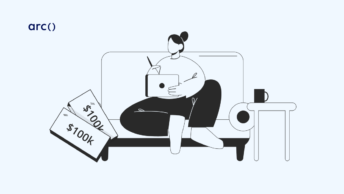No matter which route you take to get into software development, we all land up at the same point eventually, looking for that first, seemingly elusive job. It’s a common story, told by many a job seeker no matter the industry, “I just can’t seem to get a response,” “I get to interview but apparently I’m never a good fit for the role,” and “I can’t find a job I meet the requirements for.”
The job search process can be demoralizing and confusing, made worse by many companies’ reluctance to give any actionable feedback to help you improve. All of this is exacerbated when looking remotely, because everyone is reduced to 2D floating heads on a poor-resolution Zoom connection with all the vital body language and personal rapport stripped away.
Having been there myself on both the hiring and applying side and mentoring people though job searches, I know the pain, so I’m going to cover some of things that might be tripping you up. Which of the following job searching sins are you committing?
Looking to hire the best remote developers? Explore HireAI to see how you can:
⚡️ Get instant candidate matches without searching
⚡️ Identify top applicants from our network of 300,000+ devs with no manual screening
⚡️ Hire 4x faster with vetted candidates (qualified and interview-ready)
Try HireAI and hire top developers now →
Common Job Search Mistakes: Pre-Application Phase
No evidence you can do the job
When you first start out, you won’t have a lot of evidence available proving you can do the job of a software developer. And, while the expectations of a junior developer are lower than you probably think, it is still required that you can build things with code.
A small selection of functional demo applications on a portfolio site goes a long way to demonstrating this — your own simple website or something like Troopl is fine. Many people fear that their portfolio projects aren’t unique or interesting enough, but it’s important to remember that you are being hired to solve problems, with code, for a company with lots of people already working in it. They don’t need you to be a visionary, they need you to be a builder, showing you can build a to-do or weather app that they can go and use in some way is plenty.
Keep your portfolio projects small, functional, and complete to avoid getting overlooked by recruiters.
Being too picky
When looking for your first junior software development job, accept that it probably isn’t going to be your dream job. There are far more developers at non-tech firms that you’ve never heard of than there are at Google, Apple, or Shopify. A first job at a regional retailer or small agency doesn’t preclude you from one day working for one of the big tech firms.
In fact, a year or two working on a 20-year-old IT estate at a mid-sized auto parts supplier updating old technology, maintaining PHP backends, and managing an enormous SQL database that hasn’t been offline in over a decade will help you land that eventual dream job.
Read More: How to REALLY Get a Job as a Self-Taught Developer
No market research
When looking for your first developer job, it’s vital you do your market research. Answer questions such as:
- What’s the most in-demand coding language or tech stack right now?
- Which areas are growing quickly, and which are in decline?
- What’s the realistic salary range for someone with your experience?
- What technological trends are companies keen on now?
These sorts of questions don’t take long to answer. But, having an idea of what’s happening in the wider market and within the tech world can guide your search and help you perform better in interviews.
Skill list paralysis
Much like decision paralysis leads us to make no choice when presented with too many options, skill list paralysis is when the skills list for a role is so long that you don’t apply.
You see, job listings are a wish list. Very few people will hit all the requirements of a typical developer job listing. Companies know this and fully expect to receive applications from people who hit far less than the total number of listed languages, frameworks, and technical skills.
So, the next time you see eight required skills and you only have five, apply anyway. Fundamentally, a developer must be able to do one thing: solve problems with code. Everything after that is a nice-to-have.
Read More: Here’s When You Can TRULY Call Yourself a “Senior” Software Developer
Arc is a radically different remote job search platform where companies apply to you. We feature developers directly to tech companies and startups and help you land a remote job in 14 days.
Sign up here.
Things to Avoid on Your Job Application
No Name
I have received so many applications that start with “Dear Sirs” or “Dear Sir/Madam,” and they nearly all get immediately dismissed.
Not taking 5 minutes to find a name to put on your cover letter or job application is an indicator that perhaps you’re not taking this job search very seriously. Or, maybe you’re just applying for a lot of open positions without much care or thought. When you skip finding a name, you’re skipping a simple step that goes a long way to signaling you care about this application and making a small bond with the hiring manager or recruiter.
Many people say that they can’t find a name. But, the thing is, you can always find a name — you can search for a company recruiter on LinkedIn, you can ring reception and ask them for a suggestion, or, if you get desperate, you can even use the name of the Head of HR or the CEO.
You might not know the name of the recruiter at Tesla or Apple, but, without even searching, you can address an application to Mr. Musk or Mr. Cook. Much better than nothing!
Read More: How to Write a Software Engineer Cover Letter
LinkedIn Easy Apply
Speaking of LinkedIn, let’s take a second to talk about Easy Apply. On the surface, this feature is there to save you time, reduce the work required to apply for jobs, and generally increase your chances of getting that job.
None of these are the reason this feature exists, however. This feature is there to get as many applicants as possible per role so that LinkedIn looks good to employers listing jobs on the platform — a selling point to hiring managers essentially saying, “we get you 5 times more applications per role than Indeed!”
Sadly, the tradeoff to this is that companies are deluged with engineering candidates. And, rather than meticulously reading each application and judging them on their merits, they look for any reason to cull the pile to a manageable number.
For instance, if they think they can find a hireable applicant in 50 applications, and they have received 100, then it doesn’t really matter which 50% they get rid of. That’s a 50% chance you get rejected without your application even being looked at. Far better to go through a lower volume application channel.
Read More: 10+ Important LinkedIn Best Practices for Remote Software Developers
Dismissing recruiters
On the topic of a lower volume channel, don’t dismiss recruiters. Recruiters get a bad rap in the software development world. Just ask any seasoned developer, and you will hear of how many annoying messages and calls they get and how recruiters don’t know anything about tech.
The truth is that a good recruiter can be a massive time-saver in your job search, because they know the market and they know lots of companies who are actively hiring developers. When you speak to a recruiter, you aren’t really applying for just one role, you are applying for all the roles that recruiter has available with every client on their books.
This means one conversation often turns into multiple applications. Even better, those applications are being sent straight to the most relevant person in the company by someone they trust. While you have no reputation with the company, the recruiter does, and they won’t want to mess that up. Meaning they will only forward you on if they think you are a viable candidate, because, otherwise, they risk damaging their reputation.
Read More: When You’re Ready to Go From Junior Developer to Mid-Level Developer
Generic applications
Each application needs to be tailored for the specific software development role you’re applying to. This doesn’t mean it needs to be rewritten from scratch, but you do need to read the job specification and make clear links between it and your experience. The fastest way to do this is to have a large “Foundational CV” or “Master Resume” that contains lots of bullet points for all the different things you have done. Then, include only the most relevant ones for the role.
Make it easy for the recipient to see how you fit their specific role. For example, if you have worked with their technologies before, then highlight those terms on your job application. NodeJS and React in bold are easy for anyone to spot.
You can also use some of the same phrasings they do. For instance, if your software developer CV has a bullet point that says, “worked with AWS Lambda and messaging queues” and the job description says “knowledge and experience in modern serverless infrastructure,” then rephrase your bullet point to include that.
Make it easy for them to see how you match the role.
Read More: 10+ Tips for Preparing for a Remote Developer Zoom Interview
Post-Application Mistakes to Avoid
Poor communications
There are two parts to this, and the first is to make sure you give good, coherent answers to any questions you are asked. Make sure to read back over text communications before hitting send, take a second to think about a response before starting to speak, and, if you don’t understand what you have been asked, be brave enough to ask if they can rephrase.
There are many standard interview questions that can be answered with the same examples from your past. Make sure to take time to prepare three or four that demonstrate how you work well in a team, hit deadlines, manage your workload, and work through difficult problems.
Secondarily, in this new, remote-first world, you can really set yourself apart from the crowd by having a good webcam and microphone. And, you don’t need to spend a fortune, either. Good lighting in your room can help a $40 webcam look very crisp, and a cheap gaming headset from Amazon combined with a pillow strategically placed out of sight under your monitor will dramatically improve your audio quality.
Do a test call with a family member or friend to check the position of the mic so your breathing isn’t picked up (pro tip: twist the mic flat so you speak across it to reduce breathing and plosions), and get that pillow positioned so there’s minimal echo.
Not asking questions
“Do you have any questions for us?“
You know it’s coming toward the end of any interview, so prepare for it. Not asking questions is worse than asking a stupid question. If you are stuck on what to ask, then follow my Interview Question Framework to get at least 3 questions:
- A question that is unique to the person you are talking to, such as: “As a team lead, how do you prioritize the day-to-day activities of the team and balance that with the longer-term objectives of the company or department?”
- One that is unique to the company, for example: “What’s the most exciting project on the horizon you can talk about?”
- Something that is quite generic, such as: “What would success look like three months into this role?”
Read More: 8 Behavioral Interview Questions Asked by Top Tech Companies
Not following up
Once you have applied for the role, don’t step back and be passive. Follow up to make sure your application has been received. A friendly phone call or email goes a long way to checking that your application made it to the relevant inbox. It also helps you stand out in their mind as the person who follows up.
If you’ve had an interview and it’s been a few days of unexpected silence from them, send a follow-up email or phone call. It can feel like you are being a nuisance, but you are not. Rather, you are showing tenacity, and that is a very good trait in a developer.
Your aim here is to get to a yes or no as briskly as possible. You’re not applying for jobs for fun, you need a job! For this reason, a quick no is as good as a yes, and showing you care only helps your cause.
Failing the tests
Technical tests are the bane of many a developer’s job search. No matter the years of experience or seniority, it only takes a question type you’ve not come across before, and it can be game over. The best thing is to practice. CodeWars, HackerRank, and Educative all have great examples, courses, and challenges that you can work through. Try to focus on picking up patterns, because many interview questions often fall into several styles and can be solved with similar approaches.
For take-home tests, include a readme doc detailing any assumptions you made, shortcuts you took, and how they can run your code. Make sure to include tests of some kind, either with a dedicated tool like Jest or your own tests.
For live tests where you are coding and sharing your screen with someone, make sure to:
- Always talk through what you are doing — silence is your enemy!
- Make sure you understand the task. Explain it back to the interviewer, and get them to confirm you’re correct.
- If you are skipping anything (like tests), highlight that and say why.
- Clarify the rules of engagement. For example, is Googling allowed?
- Confirm how long you have available to work on this. They likely don’t expect you to complete the exercise within the time limit, but rather they want to see your approach and tactics. So, don’t rush unnaturally.
Read More: 5 Ways to Stand Out & Get Noticed in Your Current Development Job
Wrapping Up
Landing a job at any stage in your career is a challenge.
Regardless of how much developers are in demand or how deep the skills shortage is, you will receive more job application rejections than you do offers. Unfortunately, that’s just the mathematics of how this system works.
To land your first, or next, developer job, you need to take the time to learn the process, accept that it really has very little to do with the day-to-day of software development, and leverage what you can from the system.
You can also explore HireAI to skip the line and:
⚡️ Get instant candidate matches without searching
⚡️ Identify top applicants from our network of 250,000+ devs with no manual screening
⚡️ Hire 4x faster with vetted candidates (qualified and interview-ready)









